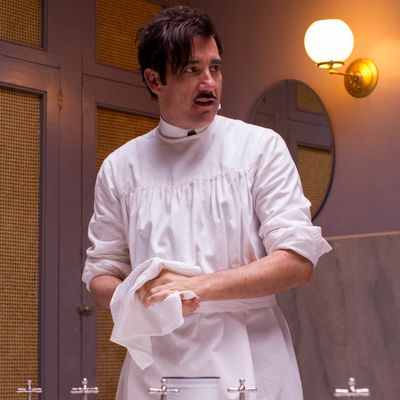
When they worked together on the thriller Contagion, director Steven Soderbergh gave production designer Howard Cummings a mantra to live by: “The real thing is scarier than anything anyone could make up.” No matter how technical, no matter how dry, for Soderbergh, verisimilitude was the key to hooking an audience. When Cummings joined The Knick, the same rules applied.
“Steven was interested in the surgical practices and that they be as realistic as possible,” Cummings says of the element that attracted his collaborator to do ten episodes of cable TV, the last of which airs tonight. To best emulate operations as they would have been performed in 1900 New York City, the production hired both historical advisers and modern surgeons, who instructed Clive Owen and his co-stars in the way of the scalpel. Cummings’s task was to apply that same primary-source-driven approach to the rest of the show. The production designer walked us through the styling decisions Knick fans should note.
The Bloody Center of It All
The Knickerbocker’s surgical theater is the heart of The Knick. To capture its mood, Cummings turned to Thomas Eakin’s 1889 oil painting The Agnew Clinic. The work of art depicts surgeon David Hayes Agnew standing in the center of the medical amphitheater as his team performs a partial mastectomy. “At the time, it was very shocking,” Cummings says of Eakin’s graphic approach.
Fond of its colors and direct lighting, Cummings combined the painting’s ideas with Soderbergh’s wishful thinking. “Steven told me early on that if the show could be shot in all black and white, he would do it,” says the production designer. (No surprise: David Lynch’s Elephant Man was an oft-discussed reference point when it came to The Knick.) Shooting a colorized TV show with a monochromatic mentality became an invigorating challenge for Cummings. He would steer the hospital towards the edge of pure black-and-white. Greys and browns would pervade the outside world. A duller palette, Cummings says, would leave room for vivid explosions. “The real color is blood.”
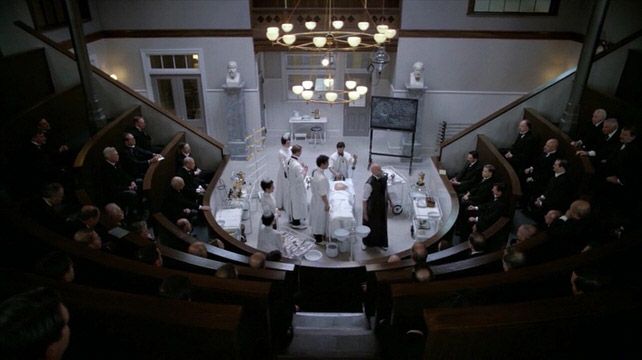
Even on a soundstage, building the surgical theater was a monumental task. Cummings found few movies that constructed a set so voluminous and that would allow for high-angle perspectives. He had little to go off. “In a test build, it barely squeezed between the rafters of our studios. It can seat about 150. Some of those operating theaters were even bigger, accommodating 300.”
The Nose Knows
The Knick’s assortment of blood and guts were crafted specifically for the show, but Cummings, sighing with relief, admits he wasn’t too involved (or particular) with the gore. More important were the calmer cases. The syphilis-afflicted Abigail Alford, who arrives at John Thackery’s office with a facial disfigurement, was a major design question — how much of her nose would and could be missing?
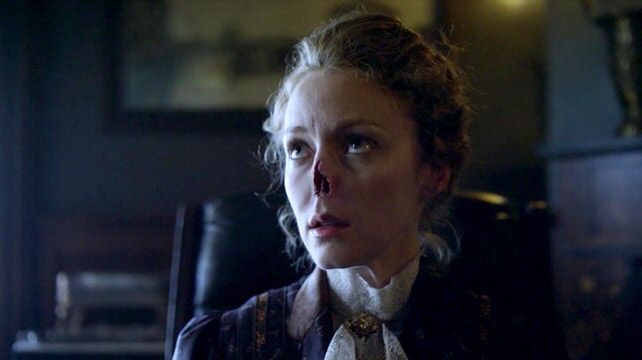
“I had pictures of patients from the times that I sorted through,” Cumming says with trepidation. “It could have been so much worse. It was about how much of the bone was actually left.” The designer consulted with Dr. Stanley Burns, who allowed Cummings to browse his medical photography archive, a collection of over 700,000 vintage pictures (you can see a few on the Burns Archive website). He found the rig that eventually grafts Abigail’s arm to her nose socket in old medical catalogues. “It was used for a lot of skin grafts, burns and things,” Cummings says.
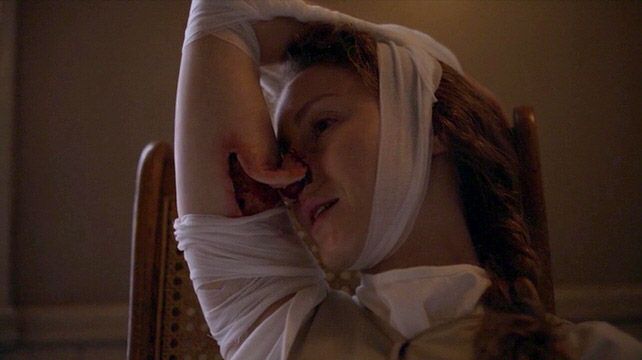
Design As Recreation, Replication
The Knick is a who’s who of preserved New York City buildings. The metropolis’s architectural relics are few and far between, constant overhauls and renovations plowing over early 20th-century history, but enough remained to make Cummings’s job more about set dressing than constructing buildings from the ground up. Dr. Christiansen’s house, seen early in the series, was an untouched mansion in Brooklyn’s Clinton Hill neighborhood. Thackery’s home was a bed-and-breakfast in Harlem. Cornelia Robertson’s house was a few blocks away on 151st Street and St. Nicholas Avenue — one of the few Victorian mansions left in the city. And it still had its kitchen.
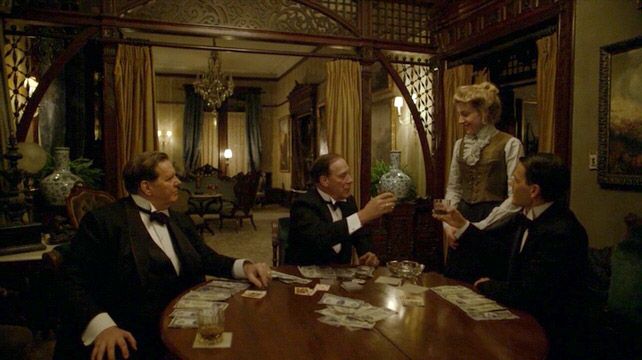
“When you see the cooks below, that was all in the house,” Cummings says. “It was a challenge because it was derelict, but it was worth it in the end. That Gilded Age Victorian house fell out of fashion after 1904. All the rich people, like the Astors, started tearing down their houses to build more classical-looking ones with less detail.”
Resurrecting the Knickerbocker
For The Knick’s main stage, Cummings needed a distinct landmark. He barely had to touch Boys’ High School in Brooklyn’s Bedford–Stuyvesant neighborhood, a national landmark designed by James Naughton and erected in 1891. “All the windows are different shapes, big, sweeping carves. It had an archaic quality to it that I thought was really good for everything that was going on inside the Knick.”

Originally, the plan was to shoot The Knick in a now-abandoned Williamsburg hospital from 1904. But even a few years into the century, Cummings says that a push from the industrial revolution regimented architecture (and the medical practices inside). It didn’t feel right. “We thought we’d use that, but all the windows are laid out evenly. There’s order to it. Our hospital was older and shouldn’t be like that. Our hospital wants to be that.”
Since the Boys’ High School is an active school, Cummings still had to design and build all the hospital interiors. Archives from the Columbia School of Medicine made it easy. In the school’s records, Cummings and his team found reports dating back to the 1880s that detailed New York’s Presbyterian Hospital innards, from floor plans to photographs of doctors in action. Bed layouts, nurse assignments, recovery-room blueprints, even where the instruments were placed in relation to the doctor — all Cummings had to do was dimensionalize it. The Knick set replicates everything down to the original heating system and vent placement.
That left plenty of room for innovation when the show ventured outdoors. New Yorkers stood in shock last year as Soderbergh transformed modern Brooklyn into a den of dirty roads and horse-drawn carriages. Cummings was very particular about the dirt. In the Lower East Side and Chinatown sets, he used very dark brown dirt, making it as muddy as possible. Compare that to outside the Knick, which uses a light grey, sandy dirt. “With people dressed darkly, it reinforces the black-and-white idea.”
Old-Fashioned Lighting
When Stanley Kubrick wanted to light Barry Lyndon with candles, he shot scenes with NASA-grade lenses brightened by triple-wicked candles. Cumbersome, to say the least. When Steven Soderbergh wanted to light The Knick with as many practical gas and period-faithful bulb-lamps as possible, the magic of his RED camera saved him from resorting to trickery. Cummings says the RED’s high-tech sensors picked up even the darkest situations. “We obviously had stage lighting, but that was really lighting for daytime, lights coming through windows or skylight,” the designer says.
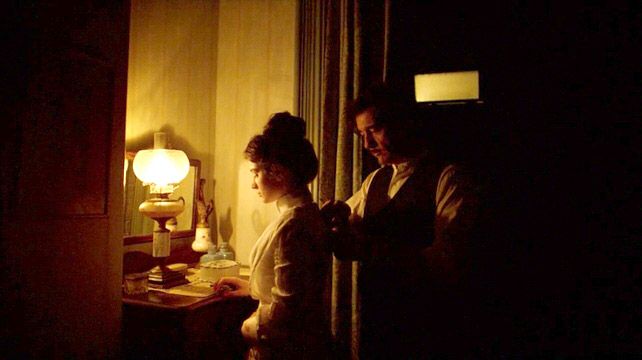
To amplify a lamp’s glow in locations like Algernon’s pop-up basement clinic or the crimson Chinatown brothels, Cummings would design sets with particular sheen that would reflect light. “Steven wanted kick, when light hits the wall, he wanted that on everything so it wasn’t flat.” If anything fell into darkness, well, that’s what would have happened in real life. “As a designer, knowing some things would be lit very darkly, I could get away [with] not detailing the hell out of something. Then I could invest in the operating theater, where it was all about the detail.” The economics of movie magic!
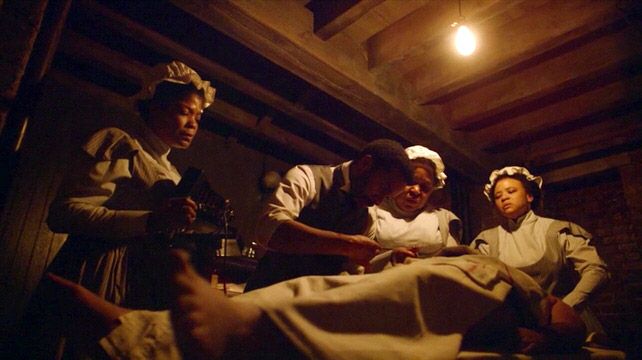
Finding Turn-of-the-Century Props by 21st-Century Means
“Thank God for eBay,” Cummings says of his grand design strategy. Approaching The Knick as found art meant scrounging up antiques from whoever might be hoarding them. He says most of the medical tools and artwork littering Dr. Christiansen’s office “came from one guy in North Carolina.” The Knick’s big purchase, the X-ray machine, was a previously functioning device from the early 1900s (though when we see it on the show, it’s not sending radiation through the actors’ skulls).

It may seem low-tech, but Cummings suggests that falling down the internet rabbit hole is the only way to find the perfect prop in this day and age: “There’s one little scene in episode one where a medical inspector goes into Farrow’s office, the superintendent, trying to hit him up for money, and he looks over and says, “Oh, are those your kids?” And there’s a cut to rotund-looking children. I knew the actors who were playing the parents, so we’d have to find kids. Those were eBay finds.”

